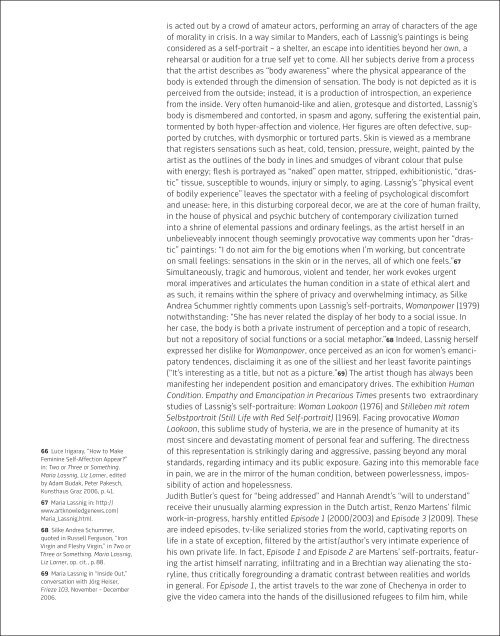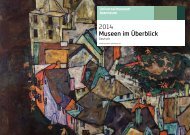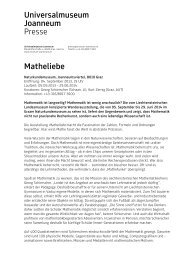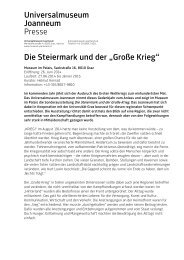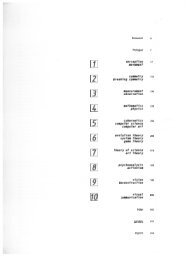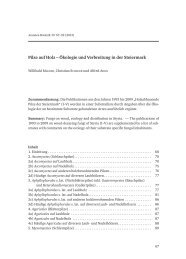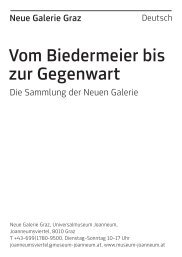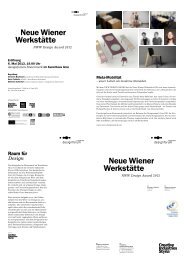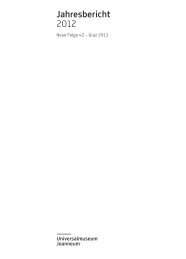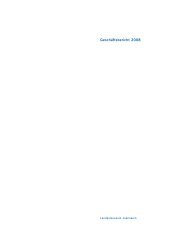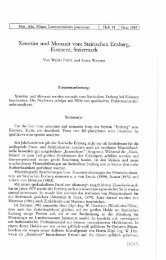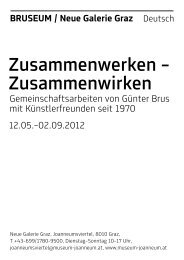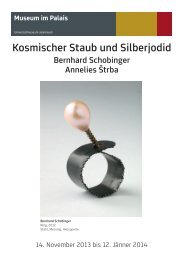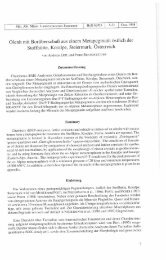Human Condition - Universalmuseum Joanneum
Human Condition - Universalmuseum Joanneum
Human Condition - Universalmuseum Joanneum
Sie wollen auch ein ePaper? Erhöhen Sie die Reichweite Ihrer Titel.
YUMPU macht aus Druck-PDFs automatisch weboptimierte ePaper, die Google liebt.
66 Luce Irigaray, “How to Make<br />
Feminine Self-Affection Appear?”<br />
in: Two or Three or Something.<br />
Maria Lassnig, Liz Larner, edited<br />
by Adam Budak, Peter Pakesch,<br />
Kunsthaus Graz 2006, p. 41.<br />
67 Maria Lassnig in: http://<br />
www.artknowledgenews.com/<br />
Maria_Lassnig.html.<br />
68 Silke Andrea Schummer,<br />
quoted in Russell Ferguson, “Iron<br />
Virgin and Fleshy Virgin,” in Two or<br />
Three or Something. Maria Lassnig,<br />
Liz Larner, op. cit., p. 88.<br />
69 Maria Lassnig in “Inside Out,”<br />
conversation with Jörg Heiser,<br />
Frieze 103, November – December<br />
2006.<br />
is acted out by a crowd of amateur actors, performing an array of characters of the age<br />
of morality in crisis. In a way similar to Manders, each of Lassnig’s paintings is being<br />
considered as a self-portrait – a shelter, an escape into identities beyond her own, a<br />
rehearsal or audition for a true self yet to come. All her subjects derive from a process<br />
that the artist describes as “body awareness“ where the physical appearance of the<br />
body is extended through the dimension of sensation. The body is not depicted as it is<br />
perceived from the outside; instead, it is a production of introspection, an experience<br />
from the inside. Very often humanoid-like and alien, grotesque and distorted, Lassnig’s<br />
body is dismembered and contorted, in spasm and agony, suffering the existential pain,<br />
tormented by both hyper-affection and violence. Her figures are often defective, supported<br />
by crutches, with dysmorphic or tortured parts. Skin is viewed as a membrane<br />
that registers sensations such as heat, cold, tension, pressure, weight, painted by the<br />
artist as the outlines of the body in lines and smudges of vibrant colour that pulse<br />
with energy; flesh is portrayed as “naked” open matter, stripped, exhibitionistic, “drastic”<br />
tissue, susceptible to wounds, injury or simply, to aging. Lassnig’s “physical event<br />
of bodily experience” leaves the spectator with a feeling of psychological discomfort<br />
and unease: here, in this disturbing corporeal decor, we are at the core of human frailty,<br />
in the house of physical and psychic butchery of contemporary civilization turned<br />
into a shrine of elemental passions and ordinary feelings, as the artist herself in an<br />
unbelieveably innocent though seemingly provocative way comments upon her “drastic”<br />
paintings: “I do not aim for the big emotions when I’m working, but concentrate<br />
on small feelings: sensations in the skin or in the nerves, all of which one feels.”67<br />
Simultaneously, tragic and humorous, violent and tender, her work evokes urgent<br />
moral imperatives and articulates the human condition in a state of ethical alert and<br />
as such, it remains within the sphere of privacy and overwhelming intimacy, as Silke<br />
Andrea Schummer rightly comments upon Lassnig’s self-portraits, Womanpower (1979)<br />
notwithstanding: “She has never related the display of her body to a social issue. In<br />
her case, the body is both a private instrument of perception and a topic of research,<br />
but not a repository of social functions or a social metaphor.”68 Indeed, Lassnig herself<br />
expressed her dislike for Womanpower, once perceived as an icon for women’s emancipatory<br />
tendences, disclaiming it as one of the silliest and her least favorite paintings<br />
(“It’s interesting as a title, but not as a picture.”69) The artist though has always been<br />
manifesting her independent position and emancipatory drives. The exhibition <strong>Human</strong><br />
<strong>Condition</strong>. Empathy and Emancipation in Precarious Times presents two extraordinary<br />
studies of Lassnig’s self-portraiture: Woman Laokoon (1976) and Stilleben mit rotem<br />
Selbstportrait (Still Life with Red Self-portrait) (1969). Facing provocative Woman<br />
Laokoon, this sublime study of hysteria, we are in the presence of humanity at its<br />
most sincere and devastating moment of personal fear and suffering. The directness<br />
of this representation is strikingly daring and aggressive, passing beyond any moral<br />
standards, regarding intimacy and its public exposure. Gazing into this memorable face<br />
in pain, we are in the mirror of the human condition, between powerlessness, impossibility<br />
of action and hopelessness.<br />
Judith Butler’s quest for “being addressed” and Hannah Arendt’s “will to understand”<br />
receive their unusually alarming expression in the Dutch artist, Renzo Martens’ filmic<br />
work-in-progress, harshly entitled Episode 1 (2000/2003) and Episode 3 (2009). These<br />
are indeed episodes, tv-like serialized stories from the world, captivating reports on<br />
life in a state of exception, filtered by the artist/author’s very intimate experience of<br />
his own private life. In fact, Episode 1 and Episode 2 are Martens’ self-portraits, featuring<br />
the artist himself narrating, infiltrating and in a Brechtian way alienating the storyline,<br />
thus critically foregrounding a dramatic contrast between realities and worlds<br />
in general. For Episode 1, the artist travels to the war zone of Chechenya in order to<br />
give the video camera into the hands of the disillusioned refugees to film him, while


